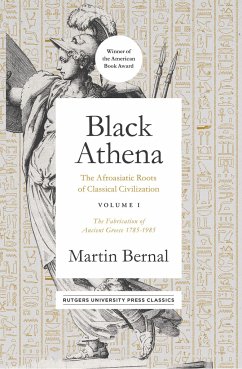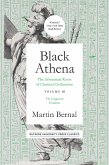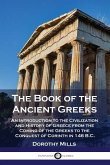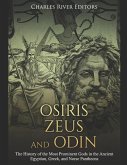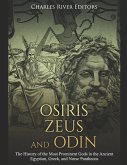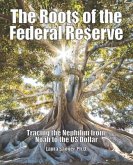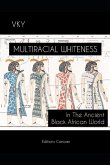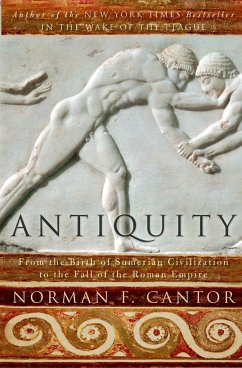Martin Bernal
Black Athena: The Afroasiatic Roots of Classical Civilization Volume I: The Fabrication of Ancient Greece 1785-1985 Volume 1
Martin Bernal
Black Athena: The Afroasiatic Roots of Classical Civilization Volume I: The Fabrication of Ancient Greece 1785-1985 Volume 1
- Broschiertes Buch
- Merkliste
- Auf die Merkliste
- Bewerten Bewerten
- Teilen
- Produkt teilen
- Produkterinnerung
- Produkterinnerung
Black Athena, an audacious three-volume series, strikes at the heart of today's most heated culture wars. Martin Bernal challenges Eurocentric attitudes by calling into question conventional explanations for the origins of classical civilization. Provocative, passionate, and colossal in scope, this thoughtful rewriting of history continues to stir academic and political controversy.
Andere Kunden interessierten sich auch für
![Black Athena: The Afroasiatic Roots of Classical Civilation Volume III: The Linguistic Evidence Volume 3 Black Athena: The Afroasiatic Roots of Classical Civilation Volume III: The Linguistic Evidence Volume 3]() Martin BernalBlack Athena: The Afroasiatic Roots of Classical Civilation Volume III: The Linguistic Evidence Volume 345,99 €
Martin BernalBlack Athena: The Afroasiatic Roots of Classical Civilation Volume III: The Linguistic Evidence Volume 345,99 €![The Book of the Ancient Greeks: An Introduction to the Civilization and History of Greece from the Coming of the Greeks to the Conquest of Corinth in The Book of the Ancient Greeks: An Introduction to the Civilization and History of Greece from the Coming of the Greeks to the Conquest of Corinth in]() Dorothy MillsThe Book of the Ancient Greeks: An Introduction to the Civilization and History of Greece from the Coming of the Greeks to the Conquest of Corinth in18,99 €
Dorothy MillsThe Book of the Ancient Greeks: An Introduction to the Civilization and History of Greece from the Coming of the Greeks to the Conquest of Corinth in18,99 €![Osiris, Zeus, and Odin: The History of the Most Prominent Gods in the Ancient Egyptian, Greek, and Norse Pantheons Osiris, Zeus, and Odin: The History of the Most Prominent Gods in the Ancient Egyptian, Greek, and Norse Pantheons]() Markus CarabasOsiris, Zeus, and Odin: The History of the Most Prominent Gods in the Ancient Egyptian, Greek, and Norse Pantheons19,99 €
Markus CarabasOsiris, Zeus, and Odin: The History of the Most Prominent Gods in the Ancient Egyptian, Greek, and Norse Pantheons19,99 €![Osiris, Zeus, and Odin: The History of the Most Prominent Gods in the Ancient Egyptian, Greek, and Norse Pantheons Osiris, Zeus, and Odin: The History of the Most Prominent Gods in the Ancient Egyptian, Greek, and Norse Pantheons]() Markus CarabasOsiris, Zeus, and Odin: The History of the Most Prominent Gods in the Ancient Egyptian, Greek, and Norse Pantheons20,99 €
Markus CarabasOsiris, Zeus, and Odin: The History of the Most Prominent Gods in the Ancient Egyptian, Greek, and Norse Pantheons20,99 €![The Roots of the Federal Reserve: Tracing the Nephilim from Noah to the US Dollar The Roots of the Federal Reserve: Tracing the Nephilim from Noah to the US Dollar]() Laura SangerThe Roots of the Federal Reserve: Tracing the Nephilim from Noah to the US Dollar31,99 €
Laura SangerThe Roots of the Federal Reserve: Tracing the Nephilim from Noah to the US Dollar31,99 €![Multiracial Whiteness In The Ancient Black African World Multiracial Whiteness In The Ancient Black African World]() Y.Multiracial Whiteness In The Ancient Black African World26,99 €
Y.Multiracial Whiteness In The Ancient Black African World26,99 €![Antiquity Antiquity]() Norman F CantorAntiquity19,99 €
Norman F CantorAntiquity19,99 €-
-
-
Black Athena, an audacious three-volume series, strikes at the heart of today's most heated culture wars. Martin Bernal challenges Eurocentric attitudes by calling into question conventional explanations for the origins of classical civilization. Provocative, passionate, and colossal in scope, this thoughtful rewriting of history continues to stir academic and political controversy.
Hinweis: Dieser Artikel kann nur an eine deutsche Lieferadresse ausgeliefert werden.
Hinweis: Dieser Artikel kann nur an eine deutsche Lieferadresse ausgeliefert werden.
Produktdetails
- Produktdetails
- Verlag: Rutgers University Press
- Seitenzahl: 669
- Altersempfehlung: ab 18 Jahre
- Erscheinungstermin: 14. Februar 2020
- Englisch
- Abmessung: 200mm x 129mm x 41mm
- Gewicht: 694g
- ISBN-13: 9781978804265
- ISBN-10: 1978804261
- Artikelnr.: 56974270
- Herstellerkennzeichnung
- Libri GmbH
- Europaallee 1
- 36244 Bad Hersfeld
- 06621 890
- Verlag: Rutgers University Press
- Seitenzahl: 669
- Altersempfehlung: ab 18 Jahre
- Erscheinungstermin: 14. Februar 2020
- Englisch
- Abmessung: 200mm x 129mm x 41mm
- Gewicht: 694g
- ISBN-13: 9781978804265
- ISBN-10: 1978804261
- Artikelnr.: 56974270
- Herstellerkennzeichnung
- Libri GmbH
- Europaallee 1
- 36244 Bad Hersfeld
- 06621 890
MARTIN BERNAL (1937-2013) was a British scholar of modern Chinese political history and a Professor of Government and Near Eastern Studies at Cornell University in Ithaca, New York. His celebrated Black Athena trilogy is a controversial series which argues that Ancient Greek civilization and language are Eastern and Egyptian in origin.
Preface and Acknowledgements
Transcription and Phonetics
Maps and Charts
Chronological Table
Introduction
Background
Proposed historical outline
Black Athena, Volume I: a summary of the argument
Greece European or Levantine? The Egyptian and West Semitic
Components of Greek Civilization / a summary of Volume 2
Solving the Riddle of the Sphinx and Other Studies in Egypto-Greek
Mythology / a summary of Volume
1 The Ancient Model in Antiquity
Pelasgians
Ionians
Colonization
The colonizations in Greek tragedy
Herodotos
Thucydides
Isokrates and Plato
Aristotle
Theories of colonization and later borrowing in the Hellenistic world
Plutarch’s attack on Herodotos
The triumph of Egyptian religion
Alexander son of Ammon
2 Egyptian wisdom and Greek transmission
From the Dark Ages to the Renaissance
The murder of Hypatia
The collapse of Egypto-Pagan religion
Christianity, stars and fish
The relics of Egyptian religion: Hermeticism, Neo-Platonism and Gnosticism
Hermeticism – Greek, Iranian, Chaldaean or Egyptian?
Hermeticism and Neo-Platonism under early Christianity, Judaism and Islam
Hermeticism in Byzantium and Christian Western Europe
Egypt in the Renaissance
Copernicus and Hermeticism
Hermeticism and Egypt in the 16th century
3 The triumph of Egypt in the 17th and 18th centuries
Hermeticism in the 17th century
Rosicrucianism: Ancient Egypt in Protestant countries
Ancient Egypt in the 18th century
The 18th century: China and the Physiocrats
The 18th century: England, Egypt and the Freemasons
France, Egypt and ‘progress’: the quarrel between Ancients and Moderns
Mythology as allegory for Egyptian science
The Expedition to Egypt
4 Hostilities to Egypt in the 18th century
Christian reaction
The ‘triangle’: Christianity and Greece against Egypt
The alliance between Greece and Christianity
‘Progress’ against Egypt
Europe as the ‘progressive’ continent
‘Progress’
Racism
Romanticism
Ossian and Homer
Romantic Hellenism
Winckelmann and Neo-Hellenism in Germany
Göttingen
5 Romantic linguistics
The rise of India and the fall of Egypt, 1740–1880
The birth of Indo-European
The love affair with Sanskrit
Schlegelian Romantic linguistics
The Oriental Renaissance
The fall of China
Racism in the early 19th century
What colour were the Ancient Egyptians?
The national renaissance of modern Egypt
Dupuis, Jomard and Champollion
Egyptian monotheism or Egyptian polytheism
Popular perceptions of Ancient Egypt in the 19th and 20th centuries
Elliot Smith and ‘diffusionism’
Jomard and the Mystery of the Pyramids
6 Hellenomania, 1
The fall of the Ancient Model, 1790–1830
Friedrich August Wolf and Wilhelm von Humboldt
Humboldt’s educational reforms
The Philhellenes
Dirty Greeks and the Dorians
Transitional figures, 1: Hegel and Marx
Transitional figures, 2: Heeren
Transitional figures, 3: Barthold Niebuhr
Petit-Radel and the first attack on the Ancient Model
Karl Otfried Müller and the overthrow of the Ancient Model
7 Hellenomania, 2
Transmission of the new scholarship to England and the rise of the Aryan
Model, 1830–60
The German model and educational reform in England
George Grote
Aryans and Hellenes
8 The rise and fall of the Phoenicians, 1830–85
Phoenicians and anti-Semitism
What race were the Semites?
The linguistic and geographical inferiorities of the Semites
The Arnolds
Phoenicians and English, 1: the English view
Phoenicians and English, 2: the French view
Salammbô
Moloch
The Phoenicians in Greece: 1820–80
Gobineau’s image of Greece
Schliemann and the discovery of the ‘Mycenaeans’
Babylon
9 The final solution of the Phoenician problem, 1885–1945
The Greek Renaissance
Salomon Reinach
Julius Beloch
Victor Bérard
Akhenaton and the Egyptian Renaissance
Arthur Evans and the ‘Minoans’
The peak of anti-Semitism, 1920–39
20th-century Aryanism
Taming the alphabet: the final assault on the Phoenicians
10 The post-war situation
The return to the Broad Aryan Model, 1945–85
The post-war situation
Developments in Classics, 1945–65
The model of autochthonous origin
East Mediterranean contacts
Mythology
Language
Ugarit
Scholarship and the rise of Israel
Cyrus Gordon
Astour and Hellenosemitica
Astour’s successor? – J. C. Billigmeier
An attempt at compromise: Ruth Edwards
The return of the Iron Age Phoenicians
Naveh and the transmission of the alphabet
The return of the Egyptians?
The Revised Ancient Model
Conclusion
Appendix Were the Philistines Greek?
Notes
Glossary
Bibliography
Index
Transcription and Phonetics
Maps and Charts
Chronological Table
Introduction
Background
Proposed historical outline
Black Athena, Volume I: a summary of the argument
Greece European or Levantine? The Egyptian and West Semitic
Components of Greek Civilization / a summary of Volume 2
Solving the Riddle of the Sphinx and Other Studies in Egypto-Greek
Mythology / a summary of Volume
1 The Ancient Model in Antiquity
Pelasgians
Ionians
Colonization
The colonizations in Greek tragedy
Herodotos
Thucydides
Isokrates and Plato
Aristotle
Theories of colonization and later borrowing in the Hellenistic world
Plutarch’s attack on Herodotos
The triumph of Egyptian religion
Alexander son of Ammon
2 Egyptian wisdom and Greek transmission
From the Dark Ages to the Renaissance
The murder of Hypatia
The collapse of Egypto-Pagan religion
Christianity, stars and fish
The relics of Egyptian religion: Hermeticism, Neo-Platonism and Gnosticism
Hermeticism – Greek, Iranian, Chaldaean or Egyptian?
Hermeticism and Neo-Platonism under early Christianity, Judaism and Islam
Hermeticism in Byzantium and Christian Western Europe
Egypt in the Renaissance
Copernicus and Hermeticism
Hermeticism and Egypt in the 16th century
3 The triumph of Egypt in the 17th and 18th centuries
Hermeticism in the 17th century
Rosicrucianism: Ancient Egypt in Protestant countries
Ancient Egypt in the 18th century
The 18th century: China and the Physiocrats
The 18th century: England, Egypt and the Freemasons
France, Egypt and ‘progress’: the quarrel between Ancients and Moderns
Mythology as allegory for Egyptian science
The Expedition to Egypt
4 Hostilities to Egypt in the 18th century
Christian reaction
The ‘triangle’: Christianity and Greece against Egypt
The alliance between Greece and Christianity
‘Progress’ against Egypt
Europe as the ‘progressive’ continent
‘Progress’
Racism
Romanticism
Ossian and Homer
Romantic Hellenism
Winckelmann and Neo-Hellenism in Germany
Göttingen
5 Romantic linguistics
The rise of India and the fall of Egypt, 1740–1880
The birth of Indo-European
The love affair with Sanskrit
Schlegelian Romantic linguistics
The Oriental Renaissance
The fall of China
Racism in the early 19th century
What colour were the Ancient Egyptians?
The national renaissance of modern Egypt
Dupuis, Jomard and Champollion
Egyptian monotheism or Egyptian polytheism
Popular perceptions of Ancient Egypt in the 19th and 20th centuries
Elliot Smith and ‘diffusionism’
Jomard and the Mystery of the Pyramids
6 Hellenomania, 1
The fall of the Ancient Model, 1790–1830
Friedrich August Wolf and Wilhelm von Humboldt
Humboldt’s educational reforms
The Philhellenes
Dirty Greeks and the Dorians
Transitional figures, 1: Hegel and Marx
Transitional figures, 2: Heeren
Transitional figures, 3: Barthold Niebuhr
Petit-Radel and the first attack on the Ancient Model
Karl Otfried Müller and the overthrow of the Ancient Model
7 Hellenomania, 2
Transmission of the new scholarship to England and the rise of the Aryan
Model, 1830–60
The German model and educational reform in England
George Grote
Aryans and Hellenes
8 The rise and fall of the Phoenicians, 1830–85
Phoenicians and anti-Semitism
What race were the Semites?
The linguistic and geographical inferiorities of the Semites
The Arnolds
Phoenicians and English, 1: the English view
Phoenicians and English, 2: the French view
Salammbô
Moloch
The Phoenicians in Greece: 1820–80
Gobineau’s image of Greece
Schliemann and the discovery of the ‘Mycenaeans’
Babylon
9 The final solution of the Phoenician problem, 1885–1945
The Greek Renaissance
Salomon Reinach
Julius Beloch
Victor Bérard
Akhenaton and the Egyptian Renaissance
Arthur Evans and the ‘Minoans’
The peak of anti-Semitism, 1920–39
20th-century Aryanism
Taming the alphabet: the final assault on the Phoenicians
10 The post-war situation
The return to the Broad Aryan Model, 1945–85
The post-war situation
Developments in Classics, 1945–65
The model of autochthonous origin
East Mediterranean contacts
Mythology
Language
Ugarit
Scholarship and the rise of Israel
Cyrus Gordon
Astour and Hellenosemitica
Astour’s successor? – J. C. Billigmeier
An attempt at compromise: Ruth Edwards
The return of the Iron Age Phoenicians
Naveh and the transmission of the alphabet
The return of the Egyptians?
The Revised Ancient Model
Conclusion
Appendix Were the Philistines Greek?
Notes
Glossary
Bibliography
Index
Preface and Acknowledgements
Transcription and Phonetics
Maps and Charts
Chronological Table
Introduction
Background
Proposed historical outline
Black Athena, Volume I: a summary of the argument
Greece European or Levantine? The Egyptian and West Semitic
Components of Greek Civilization / a summary of Volume 2
Solving the Riddle of the Sphinx and Other Studies in Egypto-Greek
Mythology / a summary of Volume
1 The Ancient Model in Antiquity
Pelasgians
Ionians
Colonization
The colonizations in Greek tragedy
Herodotos
Thucydides
Isokrates and Plato
Aristotle
Theories of colonization and later borrowing in the Hellenistic world
Plutarch’s attack on Herodotos
The triumph of Egyptian religion
Alexander son of Ammon
2 Egyptian wisdom and Greek transmission
From the Dark Ages to the Renaissance
The murder of Hypatia
The collapse of Egypto-Pagan religion
Christianity, stars and fish
The relics of Egyptian religion: Hermeticism, Neo-Platonism and Gnosticism
Hermeticism – Greek, Iranian, Chaldaean or Egyptian?
Hermeticism and Neo-Platonism under early Christianity, Judaism and Islam
Hermeticism in Byzantium and Christian Western Europe
Egypt in the Renaissance
Copernicus and Hermeticism
Hermeticism and Egypt in the 16th century
3 The triumph of Egypt in the 17th and 18th centuries
Hermeticism in the 17th century
Rosicrucianism: Ancient Egypt in Protestant countries
Ancient Egypt in the 18th century
The 18th century: China and the Physiocrats
The 18th century: England, Egypt and the Freemasons
France, Egypt and ‘progress’: the quarrel between Ancients and Moderns
Mythology as allegory for Egyptian science
The Expedition to Egypt
4 Hostilities to Egypt in the 18th century
Christian reaction
The ‘triangle’: Christianity and Greece against Egypt
The alliance between Greece and Christianity
‘Progress’ against Egypt
Europe as the ‘progressive’ continent
‘Progress’
Racism
Romanticism
Ossian and Homer
Romantic Hellenism
Winckelmann and Neo-Hellenism in Germany
Göttingen
5 Romantic linguistics
The rise of India and the fall of Egypt, 1740–1880
The birth of Indo-European
The love affair with Sanskrit
Schlegelian Romantic linguistics
The Oriental Renaissance
The fall of China
Racism in the early 19th century
What colour were the Ancient Egyptians?
The national renaissance of modern Egypt
Dupuis, Jomard and Champollion
Egyptian monotheism or Egyptian polytheism
Popular perceptions of Ancient Egypt in the 19th and 20th centuries
Elliot Smith and ‘diffusionism’
Jomard and the Mystery of the Pyramids
6 Hellenomania, 1
The fall of the Ancient Model, 1790–1830
Friedrich August Wolf and Wilhelm von Humboldt
Humboldt’s educational reforms
The Philhellenes
Dirty Greeks and the Dorians
Transitional figures, 1: Hegel and Marx
Transitional figures, 2: Heeren
Transitional figures, 3: Barthold Niebuhr
Petit-Radel and the first attack on the Ancient Model
Karl Otfried Müller and the overthrow of the Ancient Model
7 Hellenomania, 2
Transmission of the new scholarship to England and the rise of the Aryan
Model, 1830–60
The German model and educational reform in England
George Grote
Aryans and Hellenes
8 The rise and fall of the Phoenicians, 1830–85
Phoenicians and anti-Semitism
What race were the Semites?
The linguistic and geographical inferiorities of the Semites
The Arnolds
Phoenicians and English, 1: the English view
Phoenicians and English, 2: the French view
Salammbô
Moloch
The Phoenicians in Greece: 1820–80
Gobineau’s image of Greece
Schliemann and the discovery of the ‘Mycenaeans’
Babylon
9 The final solution of the Phoenician problem, 1885–1945
The Greek Renaissance
Salomon Reinach
Julius Beloch
Victor Bérard
Akhenaton and the Egyptian Renaissance
Arthur Evans and the ‘Minoans’
The peak of anti-Semitism, 1920–39
20th-century Aryanism
Taming the alphabet: the final assault on the Phoenicians
10 The post-war situation
The return to the Broad Aryan Model, 1945–85
The post-war situation
Developments in Classics, 1945–65
The model of autochthonous origin
East Mediterranean contacts
Mythology
Language
Ugarit
Scholarship and the rise of Israel
Cyrus Gordon
Astour and Hellenosemitica
Astour’s successor? – J. C. Billigmeier
An attempt at compromise: Ruth Edwards
The return of the Iron Age Phoenicians
Naveh and the transmission of the alphabet
The return of the Egyptians?
The Revised Ancient Model
Conclusion
Appendix Were the Philistines Greek?
Notes
Glossary
Bibliography
Index
Transcription and Phonetics
Maps and Charts
Chronological Table
Introduction
Background
Proposed historical outline
Black Athena, Volume I: a summary of the argument
Greece European or Levantine? The Egyptian and West Semitic
Components of Greek Civilization / a summary of Volume 2
Solving the Riddle of the Sphinx and Other Studies in Egypto-Greek
Mythology / a summary of Volume
1 The Ancient Model in Antiquity
Pelasgians
Ionians
Colonization
The colonizations in Greek tragedy
Herodotos
Thucydides
Isokrates and Plato
Aristotle
Theories of colonization and later borrowing in the Hellenistic world
Plutarch’s attack on Herodotos
The triumph of Egyptian religion
Alexander son of Ammon
2 Egyptian wisdom and Greek transmission
From the Dark Ages to the Renaissance
The murder of Hypatia
The collapse of Egypto-Pagan religion
Christianity, stars and fish
The relics of Egyptian religion: Hermeticism, Neo-Platonism and Gnosticism
Hermeticism – Greek, Iranian, Chaldaean or Egyptian?
Hermeticism and Neo-Platonism under early Christianity, Judaism and Islam
Hermeticism in Byzantium and Christian Western Europe
Egypt in the Renaissance
Copernicus and Hermeticism
Hermeticism and Egypt in the 16th century
3 The triumph of Egypt in the 17th and 18th centuries
Hermeticism in the 17th century
Rosicrucianism: Ancient Egypt in Protestant countries
Ancient Egypt in the 18th century
The 18th century: China and the Physiocrats
The 18th century: England, Egypt and the Freemasons
France, Egypt and ‘progress’: the quarrel between Ancients and Moderns
Mythology as allegory for Egyptian science
The Expedition to Egypt
4 Hostilities to Egypt in the 18th century
Christian reaction
The ‘triangle’: Christianity and Greece against Egypt
The alliance between Greece and Christianity
‘Progress’ against Egypt
Europe as the ‘progressive’ continent
‘Progress’
Racism
Romanticism
Ossian and Homer
Romantic Hellenism
Winckelmann and Neo-Hellenism in Germany
Göttingen
5 Romantic linguistics
The rise of India and the fall of Egypt, 1740–1880
The birth of Indo-European
The love affair with Sanskrit
Schlegelian Romantic linguistics
The Oriental Renaissance
The fall of China
Racism in the early 19th century
What colour were the Ancient Egyptians?
The national renaissance of modern Egypt
Dupuis, Jomard and Champollion
Egyptian monotheism or Egyptian polytheism
Popular perceptions of Ancient Egypt in the 19th and 20th centuries
Elliot Smith and ‘diffusionism’
Jomard and the Mystery of the Pyramids
6 Hellenomania, 1
The fall of the Ancient Model, 1790–1830
Friedrich August Wolf and Wilhelm von Humboldt
Humboldt’s educational reforms
The Philhellenes
Dirty Greeks and the Dorians
Transitional figures, 1: Hegel and Marx
Transitional figures, 2: Heeren
Transitional figures, 3: Barthold Niebuhr
Petit-Radel and the first attack on the Ancient Model
Karl Otfried Müller and the overthrow of the Ancient Model
7 Hellenomania, 2
Transmission of the new scholarship to England and the rise of the Aryan
Model, 1830–60
The German model and educational reform in England
George Grote
Aryans and Hellenes
8 The rise and fall of the Phoenicians, 1830–85
Phoenicians and anti-Semitism
What race were the Semites?
The linguistic and geographical inferiorities of the Semites
The Arnolds
Phoenicians and English, 1: the English view
Phoenicians and English, 2: the French view
Salammbô
Moloch
The Phoenicians in Greece: 1820–80
Gobineau’s image of Greece
Schliemann and the discovery of the ‘Mycenaeans’
Babylon
9 The final solution of the Phoenician problem, 1885–1945
The Greek Renaissance
Salomon Reinach
Julius Beloch
Victor Bérard
Akhenaton and the Egyptian Renaissance
Arthur Evans and the ‘Minoans’
The peak of anti-Semitism, 1920–39
20th-century Aryanism
Taming the alphabet: the final assault on the Phoenicians
10 The post-war situation
The return to the Broad Aryan Model, 1945–85
The post-war situation
Developments in Classics, 1945–65
The model of autochthonous origin
East Mediterranean contacts
Mythology
Language
Ugarit
Scholarship and the rise of Israel
Cyrus Gordon
Astour and Hellenosemitica
Astour’s successor? – J. C. Billigmeier
An attempt at compromise: Ruth Edwards
The return of the Iron Age Phoenicians
Naveh and the transmission of the alphabet
The return of the Egyptians?
The Revised Ancient Model
Conclusion
Appendix Were the Philistines Greek?
Notes
Glossary
Bibliography
Index

